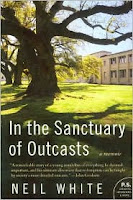 Sometimes I come across things in books that coincidentally link to something I've read in another book. This time, however, it was not a coincidence that I read two books that talked about the leprosy colony at Carville, Louisiana. Last fall I read Elise Blackwell's "The Unnatural History of Cypress Parish" which talked about the colony. I was shocked--I had no idea that there had ever been leprosy in the United States, let alone that it had survived into the last century. So when I was given the opportunity to review "In The Sanctuary of Outcasts," by Neil White, which dealt with a man who was imprisoned in the federal prison that was attached to the colony, I jumped at the chance to learn more.
Sometimes I come across things in books that coincidentally link to something I've read in another book. This time, however, it was not a coincidence that I read two books that talked about the leprosy colony at Carville, Louisiana. Last fall I read Elise Blackwell's "The Unnatural History of Cypress Parish" which talked about the colony. I was shocked--I had no idea that there had ever been leprosy in the United States, let alone that it had survived into the last century. So when I was given the opportunity to review "In The Sanctuary of Outcasts," by Neil White, which dealt with a man who was imprisoned in the federal prison that was attached to the colony, I jumped at the chance to learn more.

Blackwell had this to say about Carville:
"Lepers entering the colony at Carville in the early decades of the twentieth century were encouraged, if not coerced, to change their names. It was thought that both the lepers and their families were better off parting ways for good."
"Many a carefully drawn family tree had a stunted limb, a truncation bearing only the first name of an aunt or uncle or cousin who - though everyone had known where he or she had been taken - had disappeared as if forever into the mysterious word Carville."
White tells us this about the start of the colony at Carville:
"The plantation sat in disrepair, unoccupied for thirty years, before the State of Louisiana leased the land in 1894. The 360-acre plot, along with a decaying manor house and slave quarters, was then designated as the Louisiana Leper Home. After that, all lepers in Louisiana were sent to the remote colony. The geography was perfect for outcasts. The plantation was virtually impossible to reach by land...In the early days, doctors and nurses were reluctant to come to the home. There was no running water, little sanitation, and no budget for improvement. The first residents shared the buildings with snakes and bats."
According to White, the severity of leprosy depends on a person's natural immunity. Those with higher immunity may only notice a lighter patch of skin on their legs. In the most severe cases, the disease (which is a bacteria) can actually eat away flesh. There is, to this day, no vaccine against leprosy but there are treatments. There are approximately 6500 case of leprosy in the U.S., 3300 are active but these days, victims are able to continue with their lives as they receive treatment.
 As you can see from the above shot, all of the buildings are connected with covered hallways.
As you can see from the above shot, all of the buildings are connected with covered hallways.
Patients no longer live at Carville. It is now the National Hansen's Disease Museum. I found out more about the disease at the U.S. Department of Health and Human Services website.
How interesting! People still don't talk about it much!
ReplyDeleteI love to find things in books that make me want to look up more information. White did a great job of bringing the reader up to date on the disease but, of course, I had to verify his information. They actually treat it with antibiotics now.
ReplyDeleteI love the cover for In the Sanctuary of Outcasts - seems so serene for the topic of the book. Your post was really interesting, I never knew about any of that. Have a great week!
ReplyDeleteI know of another book about Leprosy, but it is not set in the U.S. It is called The Pearl Diver by Jeff Talarigo. I have it on my shelf, but have not read it yet. You might enjoy it as well!
ReplyDeleteWow - I didn't know there had been a leprosy colony in the States or that there are still that many cases today.
ReplyDeleteThat's really interesting. I didn't think leprosy even happened anymore in the States. It's great when you read a book that makes you want to find out more.
ReplyDeleteI have to visit Carville! I am pretty fascinated with leprosy.. I wish it was no longer in existence, but scores of people still die.. :( Great post!
ReplyDelete